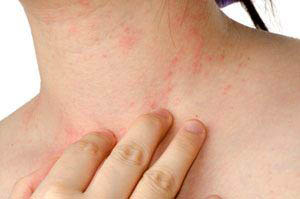Hives can make life a misery.
Sometimes referred to as urticaria or nettle rash, hives are generally linked to an allergic reaction, either to something taken internally or that has come into contact with the skin. That said, a significant number of cases have no identifiable cause.
Whether caused by allergy or not, hives usually present as patches of tiny, itchy, red blotches or blisters – the result of blood plasma leaking into your skin – that can pop up anywhere on your body. The leakage is triggered by an excess of histamine (a neurotransmitter that is part of our normal immune response). The rash can come and go quickly or last for weeks.
It goes without saying that if your think your hives are linked to an allergy the first step is to find out what you are allergic too.
Common causes include:
- Food and food additives: Common culprits include strawberries, chocolate, tree nuts, soya and dairy products. Food colouring or other ingredients in processed foods such as salicylates, sulphites and polysorbate can also be a cause. Of course, these days GM-containing foods and additives need to be considered as well as these have been implicated in increased allergic reactions.
- Medications: hives can be an allergic reaction to medicines such as antibiotics or pain medication.
- Cosmetics: preservatives like parabens and MIT, colours, fragrances and anti-bacterial agents like Triclosan can cause contact dermatitis, a form of urticaria.
- Stress: If you are prone to hives, or any other type of allergy, stress can trigger an episode.
- Insect bites: Insect venom can cause a localised reaction.
Hives can also be a reaction to heat (sometimes called prickly heat) and even sunshine – especially in spring and early summer. These sun allergies go by different names such as polymorphous light eruption (PLE), and solar urticaria, and cause the skin to react to exposure to ultraviolet radiation as if it were an allergen.
A photoallergic eruption is another related skin reaction and occurs when the sunlight interacts with a chemical that has been applied to the skin such as sunscreen, perfumes, cosmetics or antibiotic ointments.
Because of its multiple and sometimes mysterious causes, doctors are often at a loss as to the best course of treatment for urticaria. Conventional treatment usually involves antihistamines and/or steroid cream.
Sometimes an antihistamine will help bring temporary relief to a difficult to treat problem. But there are also natural approaches that are likely to work just as well.
Quick relief Try witch hazel, distilled or in a cream or gel. Soaking in a tepid bath into which you have added a couple of handfuls of baking soda can also help reduce swelling and itching. Or try an oat bath. To do this fashioning a giant ‘teabag’ out of a couple of handfuls of oats in muslin bag (or tied in a muslin cloth or a pair of old tights) and steep in your bath water.
Avoid soap When bathing avoid harsh soaps and cleansers and opt instead for mild natural cleansers. Try making your own herbal wash bag. Use a soft muslin bag or cut the foot off of an old pair of tights, about 6 inches from the end. Fill the pouch with a handful of oatmeal, some soothing herbs such as camomile or lavender and 2 tbl of finely ground almonds. Tie a knot in the open end of the pouch. You can now use this in the bath or shower. One wash bag will last one day maximum – keep it in the fridge in a plastic bag if you intend to use it morning and night, but don’t try to store it longer than this as it can accumulate bacteria. When wet it will produce a lovely creamy (soap-free) liquid which will clean and nourish sore skin without irritating it further.
Stay cool Heat can make the rash look and feel worse. In warmer weathers wear loose clothes made from natural fabrics. Use a good quality organic sunblock and apply well before you leave the house to protect sensitive areas.
Herbs Remedies such as decoctions of chickweed and borage will bring temporary relief. Brew as you would a tea and, once cooled, dab on the affected areas. Calendula cream can help soother inflamed skin. There is some evidence that tea tree oil or lavender applied to the skin may reduce allergic skin reactions caused by histamine-induced inflammation. Lavender oil may also be helpful. While these two oils can be safely applied neat to the skin as a general rule you should avoid applying essential oils in this way especially avoid citrus oils before sun exposure as these can provoke sun sensitive skin reactions. The general rule of thumb for acute conditions is a 3% dilution or 9 drop of essential oil to 1 tbl of base oil. In cases of urticaria you want an easily absorbed oil that does not sit on the skin. Jojoba is a good choice, as is apricot kernel oil.
Homoeopathy A number of homoeopathic remedies may help. Start with a 6C dose or if the rash is particularity acute a 30C. Take the remedy for a few days or until you see a change for the better. Then stop taking it.
Use Apis mellifica if burning and swelling of the lips and eyelids is made worse by heat; Urtica or Sulphur for rashes worsened by scratching, touching or bathing; Nat mur for rashes that worsen with exercise and stress; and Pulsatilla for rashes exacerbated by fatty foods. Try Dulcamara if the rash appears in hot damp weather; Rhus tox for raised blisters; and, if the rash is accompanied by restlessness and anxiety, Arsenicum.
Supplements A recent study has found that high dose vitamin D (4000 iu daily) can significantly reduce symptoms of urticaria over and above standard antihistamines. In this study the antihistamines reduced symptoms by around 33% but the addition of vitamin D reduced symptoms a further 40% over 12 weeks.
Likewise there is evidence that high beta-carotene can help reduce the incidence of sun allergy in some individuals. If you are sun sensitive try taking 25 -50 mg of beta-carotene daily. The dose may need to be higher; some recommend as high as 300mg daily increased in incremental doses. If in doubt consult a qualified practitioner.
In addition to a good quality multivitamins some practitioners recommend that sufferers aim for a daily intake of vitamin C (1,000 mg), vitamin E (400 iu) and selenium (100 mg).









